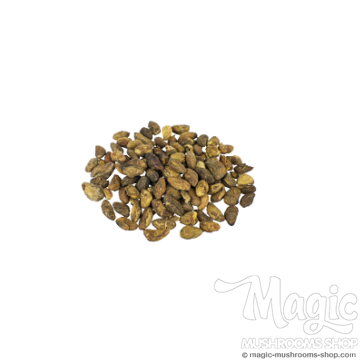Voacanga Africana Seeds
Voacanga (Voacanga Africana) seeds to cultivate your own Voacanga tree. The seeds and bark of Voacanga contain the psychoactive substances voacangine and voccamine, which are realted to ibogaine
These substances have stimulating, performance enhancing effects and can cause hallucinations in high doses. Sorcerers in West Africa use the seeds to induce visions.
Availability: In stock
Contents
Contains 5 grams of Voacanga (Voacanga Africana) seeds. In hermetically sealed packaging.
Effects of Voacanga Africana
The seeds and bark of the African tree Voacanga Africana contain the psychoactive alkaloids voacangine and voccamine. These substances can cause hallucinations and work as an aphrodisiac. They also contain stimulating effects: these substances increase your heart rate, making you alert and awake.
The chemical structure of voacangine and voaccamine resembles ibogaine, found in the Iboga shrub native to Central Africa. Ibogaine is an hallucinogen that according to some has an ‘anti-addiction’ effect. For people addicted to heorin in particular, ibogaine allegedly could potentially work medicinally, as it is supposed to alleviate withdrawal symptoms. Voacangine and voccamine are said to possess the same effects. There is little scientific proof in support of these claims.
Use of Voacanga
The highest concentration of alkaloids in Voacanga is found in the seeds: approximately 10%. These seeds can be ground with a pestle and mortar to produce a powder that can be taken orally. For a mildly stimulating trip, you’ll need about 50 seeds. High dosages can induce hallucinations.
The bark of the Voacanga tree is also eaten for its stimulating effects. The concentration of alkaloids in the bark is generally about 2%, so the effects tend to be much less intense. Some people indicate that eating the bark brings them gloomy or sad thoughts and a depressed feeling.
Cultivation of Voacanga
The Voacanga Africana tree can grow up to 6 meters tall. It’s characterized by its long, oval, green leaves, and grows white or yellow flowers. The Voacanga Africana was originally found in African rainforests. Hence, the tree is used to warm, wet environments and very sensitive to drought and frost. Voacanga Africana thrives in soil rich in compost.
To cultivate the tree, the seeds will first need to germinate. To start this process, it is recommended to soak the seeds in vinegar for about 5 minutes, causing the hard shell around the seeds to dissolve. Then, rinse the acid from the seeds and sew them about 6 centimeter deep in a deep pot filled with 3 parts of sand and 1 part of putting soil. Water the seeds very day. You might need to use some fungicide to prevent mould infections from developing.
It can take up to a few months for the seeds to finally germinate.
History
The Voacanga Africana belongs to the family of Apocynaceae or dogbane family. The tree is mostly found in the rainforests of West Africa. The hallucinogenic properties of the seeds and the bark of Voacanga Africana are used by sorcerers during initiation rituals and to induce visions. The plant is also consumed prior to hunting for its stimulating effects. The psychoactive substances in Voacanga increase alertness and stamina.
Voacanga is also used medicinally. In Nigeria and Senegal the latex of the fruits of Voacanga is used to treat wounds. A tea of the bark is supposed to relieve shortness of breath and fatigue. The plant is also used to treat various heart ailments.
Little is known about the exact ways in which Voacanga is used and treated by the indigenous peoples of West Africa, because sorcerers generally prefer to keep their methods hidden from outsiders.
| Productcode | su-va |
|---|---|
| Weight (KG) | 0.0050 |
| Portions | No |
| Contents | 5g |
| Origin | No |
| Species | No |




